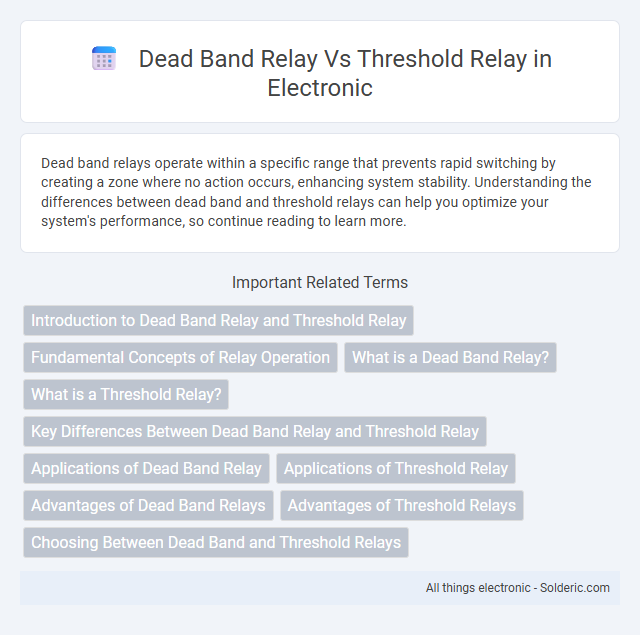Dead band relays operate within a specific range that prevents rapid switching by creating a zone where no action occurs, enhancing system stability. Understanding the differences between dead band and threshold relays can help you optimize your system's performance, so continue reading to learn more.
Comparison Table
| Feature | Dead Band Relay | Threshold Relay |
|---|---|---|
| Definition | Activates based on a range with a non-responsive "dead" zone to avoid frequent switching. | Activates when a specific threshold value is crossed. |
| Operation | Triggers only when input moves outside the dead band range. | Triggers immediately when the monitored parameter exceeds or falls below the set threshold. |
| Purpose | Prevents relay chatter by ignoring minor input fluctuations. | Detects specific critical levels for protective or control actions. |
| Switching Behavior | Delayed switching with hysteresis effect. | Instant switching on threshold breach. |
| Applications | Motor control systems, temperature regulation, noise suppression. | Overcurrent protection, voltage monitoring, safety alarms. |
| Sensitivity | Less sensitive to small changes within dead zone. | Highly sensitive to crossing specified level. |
Introduction to Dead Band Relay and Threshold Relay
Dead Band Relay operates by activating only when the measured parameter moves outside a predefined range or dead band, reducing unnecessary relay operations caused by minor fluctuations. Threshold Relay triggers when the parameter crosses a specific set value, providing fixed-point detection for protection or control purposes. Both relays are widely used in electrical and industrial systems for precise monitoring and response to varying signal levels.
Fundamental Concepts of Relay Operation
Dead Band Relays operate by maintaining a predefined non-responsive zone, preventing relay action within a set range of input values to reduce unnecessary switching due to minor fluctuations. Threshold Relays activate once the input signal crosses a specific limit or threshold, triggering an immediate response to significant changes without tolerance zones. Your choice between these relays depends on whether you need to ignore small variations with a dead band or respond instantly to threshold crossings.
What is a Dead Band Relay?
A Dead Band Relay is a control device that maintains system stability by only activating when the monitored signal moves outside a predefined neutral zone, preventing unnecessary switching due to minor fluctuations. This relay type reduces relay chatter and prolongs equipment life by ignoring small, rapid changes around a setpoint. Understanding Dead Band Relay functions helps you optimize protective measures in electrical and automation systems.
What is a Threshold Relay?
A Threshold Relay activates when a monitored parameter, such as voltage or current, exceeds a predefined limit, ensuring protective measures trigger only under fault conditions. It is designed to detect abnormal operating states by comparing real-time input against set thresholds, preventing nuisance trips. Unlike Dead Band Relays, which incorporate a hysteresis gap to avoid rapid on-off cycling, Threshold Relays operate based strictly on crossing fixed boundary values.
Key Differences Between Dead Band Relay and Threshold Relay
Dead band relays operate by activating only when the input signal moves outside a predefined neutral range, preventing frequent switching due to small signal fluctuations. Threshold relays trigger actions when the input reaches a specific preset value, without considering a neutral zone or fluctuation range. The primary difference lies in dead band relays providing hysteresis for stability, while threshold relays respond strictly to crossing fixed limits.
Applications of Dead Band Relay
Dead Band Relays are widely used in applications requiring hysteresis control to prevent frequent switching, such as motor protection, load shedding, and temperature regulation systems. These relays maintain stable operation by activating only when a signal surpasses a defined upper or lower limit with a deliberate dead zone, reducing relay chatter and wear. Industries like power generation, HVAC, and automation benefit from Dead Band Relays to enhance system reliability and efficiency by managing voltage, current, or pressure variations within controlled thresholds.
Applications of Threshold Relay
Threshold relays are commonly used in industrial automation to monitor electrical parameters such as voltage, current, or temperature, triggering alarms or protective actions when preset limits are exceeded. They ensure equipment safety by activating control circuits when conditions surpass defined thresholds, preventing damage from overloads or abnormal operating states. These relays find extensive applications in motor protection, power distribution systems, and process control environments where precise limit monitoring is critical.
Advantages of Dead Band Relays
Dead Band Relays provide enhanced stability by preventing unnecessary relay activation during minor signal fluctuations, reducing wear and prolonging the lifespan of your control equipment. They effectively filter out noise and small disturbances, which minimizes false triggering and ensures accurate system response. These advantages make Dead Band Relays ideal for applications requiring reliable performance in dynamic environments.
Advantages of Threshold Relays
Threshold relays offer precise control by activating switches only when a specific voltage or current level is exceeded, reducing false triggers and enhancing system reliability. Their simplicity in design results in faster response times and lower maintenance compared to dead band relays, which require a hysteresis range to avoid frequent toggling. This precise activation capability of threshold relays makes them ideal for applications requiring strict limits, such as overvoltage or undervoltage protection in electrical circuits.
Choosing Between Dead Band and Threshold Relays
When choosing between dead band relays and threshold relays, consider the application's sensitivity to minor fluctuations versus the necessity for a definitive switching point. Dead band relays offer stability by preventing frequent on-off cycling through a built-in hysteresis range, making them ideal for environments with noise or fluctuating signals. Threshold relays provide precise activation at specific parameter limits, suitable for systems requiring exact control and rapid response to measured variable changes.
Dead Band Relay vs Threshold Relay Infographic

 solderic.com
solderic.com